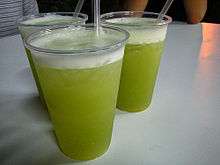Sugarcane juice


Sugarcane juice is the juice extracted from pressed sugarcane. It is consumed as a beverage in many places, especially where sugarcane is commercially grown such as Southeast Asia, Pakistan, India, Egypt, and Latin America. Evaporated cane juice as an ingredient in prepared food and beverages indicates a sweetener (a sugar) derived from sugar cane syrup.[1]
Sugarcane juice is obtained by crushing peeled sugar cane in a mill and is one of the main precursors of rum.
Health risks

Raw sugar cane juice can be a health risk to drinkers due to the unhygienic conditions under which it is prepared. There are some diseases that can be transmitted by raw sugar-cane. Leptospirosis is one.[2] In Brazil, sugarcane juice has been linked to cases of Chagas disease, as sugarcane can contain traces of Trypanosoma cruzi (the parasite responsible for the disease) left by infected bugs if not properly cleaned. [3]
There are also concerns on the use of systemic pesticides such as carbofuran used in the cultivation of sugar cane. As these pesticides are absorbed by the plant, high levels may be found in the extracted juice.
Evaporated cane juice
Evaporated cane juice is a loosely defined term that can include combinations of sugars including glucose and fructose. Evaporated cane juice is a partially purified sugar, produced from a single-crystallization process during sugar cane milling.
The US Food and Drug Administration (FDA) defines evaporated cane juice as any sweetener derived from sugarcane syrup. The US FDA considers the term “evaporated cane juice” to be misleading because the term incorrectly suggests that it is a juice, when it is sugar syrup. Instead, the US FDA recommends using “sugar cane syrup” or “dried cane syrup” on food labels.[1]
Regions
Vietnam
Sugarcane juice, called nước mía or mía đá, is very popular in Vietnam as a refreshing drink in the hot climate. Kumquat juice, a citrus, is often added to balance the sweetness.[4] It is available at small street stalls and is often sold alongside other popular Asian beverages. It was common for sugarcane juice to be sold in small plastic bags filled with ice, with the open end attached around a drinking straw by a rubber band. It is now more commonly sold in disposable plastic cups.[5]
Latin America
Attention to hygiene conditions should be given in rural areas. Drinking sugarcane juice that has been processed in a way that triatomines are milled together or where the cane has been contaminated with the insects' feces has been known in Brazil to have transmitted the Chagas disease endemic to the region (the same applies to açaí preparations – responsible for the infection, protozoans T. cruzi, can survive inside the fruit pulp even at -20 °C, equivalent to slight negative °F temperatures, for a few hours, being only really intolerant to about -30 °C).[6][7]
Brazil
In Brazil, sugarcane juice is known as caldo de cana (that is sold on a caldo-de-cana bar[8]), garapa or guarapa and is consumed fresh squeezed, most often with ice cubes.[9]
Africa
Madagascar
In the eastern region of Madagascar, sugarcane juice is fermented to make an inexpensive alcoholic beverage called betsa-betsa. The drink is popular with locals because it is cheaper than beer.[10]
See also
References
- 1 2 "DRAFT Guidance for Industry: Ingredients Declared as Evaporated Cane Juice; Draft Guidance", Food and Drug Administration, October 2009.
Joe Satran, "Trader Joe's Lawsuit Over 'Evaporated Cane Juice' Part of Firm's Crusade Against Mislabeled Foods", The Huffington Post, 29 March 2013.
- ↑ https://www.business.qld.gov.au/industry/agriculture/species/diseases-disorders/animals/leptospirosis
- ↑ http://www.fiocruz.br/chagas/cgi/cgilua.exe/sys/start.htm?sid=11
- ↑ "Sweetest at the throat". March 30, 2010. Retrieved November 7, 2011.
- ↑ "Nuoc mia, or sugar-cane juice". November 6, 2008. Retrieved November 7, 2011.
- ↑ Santa Catarina registers 19 cases of Chagas disease (catch in an unseen manner) – Everyday life – Folha de S. Paulo Online (Portuguese)
- ↑ Products with açaí can transmit Chagas disease – News – R7 Saúde (Portuguese)
- ↑ Drinking caldo de cana in a caldo-de-cana – Portuguese orthography and grammar tips – Uol Educação (Portuguese)
- ↑ "Flavors of Brazil: Caldo de Cana - Brazil's Liquid-Sugar Drink". Flavorsofbrazil.blogspot.com. 2010-09-28. Retrieved 2013-12-06.
- ↑ http://books.google.mg/books?id=yeG1AwAAQBAJ&pg=PA107&dq=betsa-betsa&hl=en&sa=X&ei=55RQVO7YHcL5ygORoYDAAg&ved=0CFIQ6AEwCA#v=onepage&q&f=false